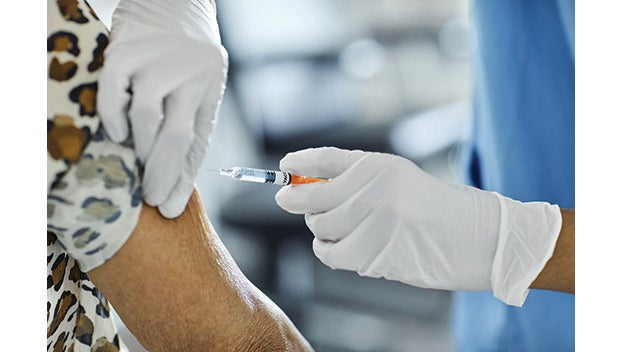CDC amends masking guidance
Published 8:30 am Friday, March 4, 2022
|
Getting your Trinity Audio player ready...
|
New guidance released Friday from the U.S. Centers for Disease Control and Prevention (CDC) has relaxed masking and other COVID-19 prevention methods for up to 70% of the country’s population, including public and private school systems, but few local counties seemed to make the cut.
It was another week of plummeting COVID-19 cases in the Piedmont Health District. According to the Virginia Department of Health (VDH), from the period of Monday, Feb. 21, to Monday, Feb. 28, Lunenburg reported 19 new COVID-19 cases.
Prince Edward saw 35 new COVID-19 cases. Buckingham County increased by 12 new cases of the virus, and Cumberland County saw 11 new virus cases. Charlotte County reported 28 new COVID-19 cases over the last week.
The state reported similar figures this week. On Monday, Feb. 28, Virginia saw 764 new COVID-19 cases, down tremendously from 1,355 cases reported the previous Monday. The state’s seven-day moving average in cases also plummeted this week from 2,552 cases Feb. 21 to 1,621 cases Feb. 28.
Unfortunately, the Piedmont Health District did appear to see an increase in COVID-related deaths over the last week. According to data pulled from VDH, Lunenburg saw one new COVID-related death this week. Prince Edward saw four new coronavirus deaths. Buckingham experienced two new COVID deaths, Cumberland reported one new death, and there were six new deaths out of Charlotte this week.
The state also appeared to reflect an uptick in its coronavirus deaths this week. On Monday, Feb. 28, Virginia saw 89 new deaths, up from 59 the week prior. The state’s seven-day average in deaths rose from 64 cases last week to 89.9 cases this week.
Local schools have continued to see lowered case numbers being reported, as well. Longwood University in Farmville was reporting one active case of the virus as of Sunday, Feb. 27. Hampden-Sydney College was reporting three active cases with zero individuals quarantining as of Friday, Feb. 25.
Area hospitals appear to also be continuing their decline in COVID-19 cases. On Monday, Feb. 28, Centra Health was reporting 53 COVID patients out of its Lynchburg, Bedford and Southside hospitals compared to 71 cases the previous week. Of the 53 patients the hospital system was caring for on Monday, four were being treated in the ICU, two of which were actively being vented.
With cases dropping and things looking up as a whole for the U.S., the CDC took a large step Friday in relaxing masking guidelines for the majority of Americans, ushering in a bigger sense of normality for roughly 63% of U.S. Counties.
During a Friday press briefing, CDC Director Dr. Rochelle Walensky and COVID-19 Incident Management Team Member Dr. Greta Massetti introduced citizens to the CDC’s new COVID-19 Community Levels tool.
The tool, according to officials, is the product of CDC’s efforts to update the framework for monitoring the level of COVID-19 in communities by focusing on directing prevention efforts towards protecting people at high risk of severe illness and preventing hospitals and health care systems from being overwhelmed.
The COVID-19 Community Levels tool uses information such as new hospitalizations for COVID-19, current hospital beds occupied by COVID patients and new COVID-19 cases to determine a county’s COVID-19 level. Those metrics, when added together, tell officials whether a community’s COVID-19 level is low, medium or high (green, yellow or red, if you’re observing the CDC’s graph tool.) The CDC then recommends different prevention steps depending on where on the scale a county lies.
According to Massetti, residents in counties with a low COVID-19 level in the community are recommended to stay up to date with COVID vaccines and get tested if they have symptoms, but it is not recommended that those residents continue to mask up.
For counties in the medium category, those at high risk for severe illness should talk to their health care provider about whether masking up and other precautions are necessary. Those individuals should also stay up to date with vaccines and get tested should they present symptoms.
For communities with a high level of transmission, the CDC recommends individuals wear masks indoors and in public, including in schools. In this category, communities are considered to have a high amount of people experiencing severe disease as well as a high potential for healthcare system strains.
“Communities can use these metrics, along with their own local metrics, such as wastewater surveillance, emergency department visits and workforce capacity, to update and further inform their local policies and ensure equity and prevention efforts,” Massetti said Friday. “And these categories help individuals assess what impacts COVID 19 is having on their community so that they can decide if they need to take extra precautions, including masking based on their location, their health status, and their risk tolerance.”
Massetti noted some people may still choose to wear a mask at any time based on personal preference, and there are situations in which people should always wear a mask, such as when testing positive for the virus or if they’ve been exposed to someone with COVID-19.
If you’re wondering how this new guidance may impact your travel plans, the Transportation Security Administration (TSA) order enforcing masking for airline passengers and transit riders is set to expire March 18, though the order could still be extended.
Along with guidance for masking in public and indoor settings came new recommendations by the CDC for masking in schools. Since July, the CDC has recommended universal masking in schools no matter the level of community transmission. With Friday’s update, officials now only recommend universal school masking in communities at the high level.
Also effective Friday, Feb. 25, the CDC does not require wearing of masks on buses or vans operated by public or private school systems, including early care and education/child care programs.
Friday’s new guidelines from the CDC have a huge impact on the majority of Americans. As of Friday, more than half of counties representing approximately 70% of Americans fell into the low or medium COVID-19 community level categories.
While the majority of U.S. citizens are now at a place in which masking up in public, indoors and even school is no longer recommended, few local counties meet this criteria.
As of Thursday, Feb. 24, Cumberland, Buckingham and Amelia counties were the only counties in the health district considered to be at the medium, or yellow, COVID-19 community level. Lunenburg, Charlotte, Nottoway and Prince Edward counties were all categorized as high, and no local counties were placed in the low category.
As it stands, the CDC still recommends citizens in Lunenburg, Charlotte, Nottoway and Prince Edward mask up while indoors and in public.
However, with local numbers still headed in the right direction, these community level figures are subject to change. To track your county’s most recent community level results, go to https://www.cdc.gov/coronavirus/2019-ncov/your-health/covid-by-county.html.
On Monday, Piedmont Health District Director Dr. Maria Almond welcomed the CDC’s new guidelines, noting the health district is awaiting further guidance.
“These long awaited changes to the CDC metrics are welcome and provide a framework that will help guide future decision-making and place the capacity of our hospital healthcare system at the center,” Almond said. “They also now more appropriately reflect the risks that COVID currently brings to a community and when increased protective measures are needed.”
In discussing the community’s future, Almond noted that while we are now better able to manage the individual and community-wide effects of the virus, it remains important to reflect on lessons learned and how we can adapt in meaningful ways to maintain a healthier community.
“There have been some advances, such as, increased public sharing of disease surveillance that I hope will continue, and which allows for individuals to have knowledge of increased periods of risk and to act on it to help protect themselves and the community,” she said. “We have developed home testing for a common illness that also gives an individual earlier warning of a need to seek medical care. It is likely that this will be a springboard to increased and convenient access to many other health services.
“We have developed on-the-ground outreach systems into our community that will benefit our abilities to better support those in need. The South Central Virginia Non-Profit Network is an example of the incredible coordinated work that grew out of this crisis. COVID has been a disrupter, but as a community, we have grown as a result and creatively responded. We have taken on renewed responsibility to care for each other. We have worked hard to vaccinate our most vulnerable. All of this work continues not only in the health department, but in our schools, in our communities of faith, in our non-profits, in the halls of government and most importantly by each of us for each other.”
Vaccination rates in each county of the health district, as of Monday, were as follows:
Lunenburg: population fully vaccinated: 55.5%, population with booster shot: 26.5%
Prince Edward: population fully vaccinated: 45.4%, population with booster shot: 23.4%
Buckingham: population fully vaccinated: 54.6%, population with booster shot: 26.2%
Cumberland: population fully vaccinated: 50.1%, population with booster shot: 22.2%
Charlotte: population fully vaccinated: 54.3%, population with booster shot: 25.2%
LOCAL VACCINATION EVENTS:
Friday, March 4 from 10 a.m. – 2 p.m. at Antioch Baptist Church located at 6700 Barnesville Highway in Red Oak.
Saturday, March 5 from 2 – 5:30 p.m. at Dollar General located at 101 Rocky Hill Road in Blackstone.
These clinics are all outdoors — dress appropriately for the weather.



